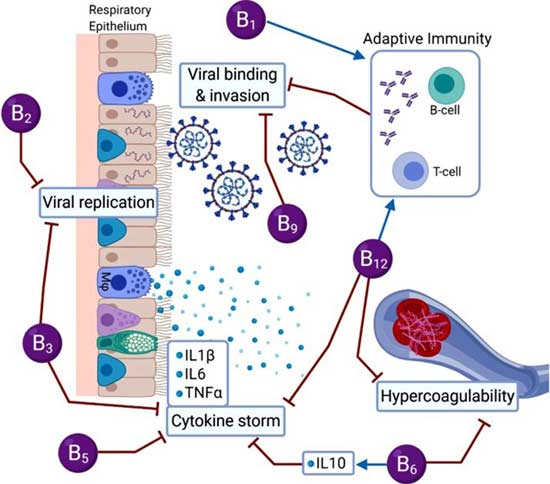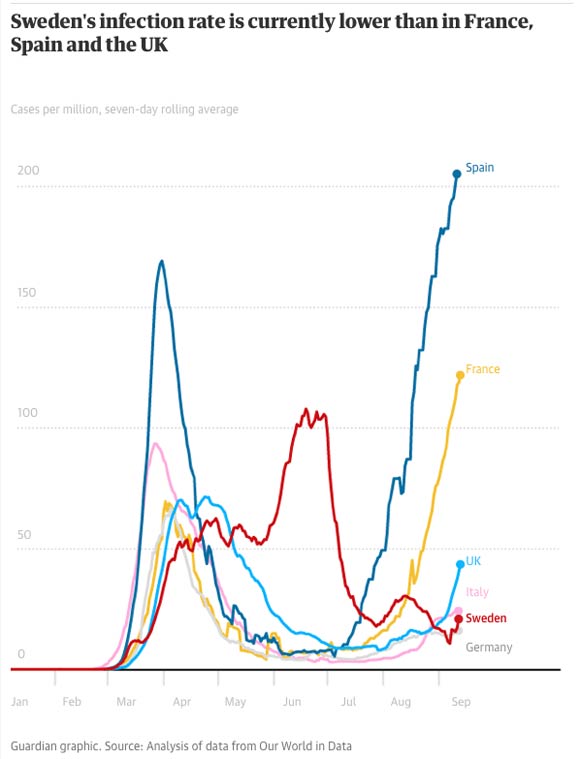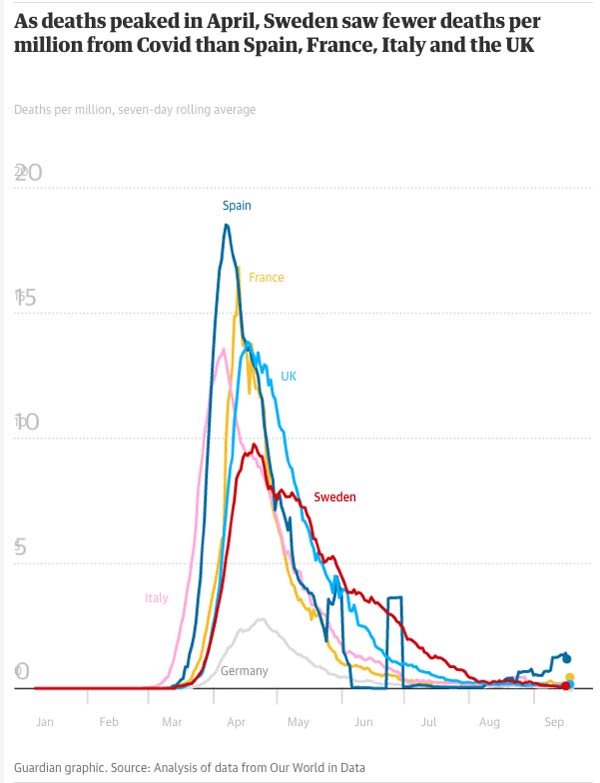B Vitamins Might Help Prevent Worst COVID-19 Outcomes
I’ve written many articles reviewing how nutrients such as vitamins C and D can help prevent and even play a role in the treatment of COVID-19. Now, researchers have highlighted the value of yet another vitamin or, rather, complex of vitamins, namely B vitamins.
The paper,1,2,3,4 “Be Well: A Potential Role for Vitamin D in COVID-19,” was published online August 15, 2020, in the journal Maturitas. The paper is the result of a joint collaboration between researchers at the University of Oxford, United Arab Emirates University and the University of Melbourne, Australia.
While no studies using B vitamins have been performed on COVID-19 patients, the researchers stress that, based on B vitamins’ effects on your immune system, immune-competence and red blood cells (which help fight infection), supplementation may be a useful adjunct to other prevention and treatment strategies. They are not suggesting B vitamins might prevent or treat COVID-19 by themselves.
Why Well-Regulated Immune Function Is Essential
One of the factors that make COVID-19 so dangerous to those with underlying conditions or old age is its ability to overactivate your immune system, triggering cytokine and/or bradykinin storms.
By strengthening and modulating immune function, in other words, making it function more appropriately and effectively, nutrients such as vitamins B, C and D can play important roles in minimizing your risk of this deadly development. As explained by Dr. Uma Naidoo, a nutrition expert at Harvard Medical School, who was not involved in the paper:5
“You can think of the immune system as an army. Its job is to protect the body. But if the immune system army isn’t well-regulated, it can overreact and actually cause more damage — this overreaction is what often happens in COVID-19 and is referred to as the cytokine storm.
Cytokines are inflammatory molecules released by immune cells. They are like the weapons of the immune system army. So, if immune cells are soldiers, cytokines are guns and grenades.
And in a poorly regulated immune system, the body’s cytokine storm induced by COVID cause lots of inflammation in the body, just as if little grenades were being tossed around. This is what causes the worst outcomes and death in COVID.
It follows that anything that improves immune system function and decreases the chances that an infected person will have a catastrophic cytokine storm may improve the outcome of COVID-19 cases and decrease the overall death rate. Therefore, it’s quite feasible that B-vitamin supplementation could contribute to preventing the worst COVID outcomes.”
B Vitamins for Healthy Immune Function
As noted by the authors of “Be Well: A Potential Role for Vitamin D in COVID-19”:6
“There is a need to highlight the importance of vitamin B because it plays a pivotal role in cell functioning, energy metabolism, and proper immune function.
Vitamin B assists in proper activation of both the innate and adaptive immune responses, reduces pro-inflammatory cytokine levels, improves respiratory function, maintains endothelial integrity, prevents hypercoagulability and can reduce the length of stay in hospital.
Therefore, vitamin B status should be assessed in COVID-19 patients and vitamin B could be used as a non-pharmaceutical adjunct to current treatments …
Vitamin B not only helps to build and maintain a healthy immune system, but it could potentially prevent or reduce COVID-19 symptoms or treat SARS-CoV-2 infection. Poor nutritional status predisposes people to infections more easily; therefore, a balanced diet is necessary for immuno-competence.”
The graphic below illustrates the roles various B vitamins play in the COVID-19 disease process. As you can see, B vitamins are involved in several disease aspects, including viral replication and invasion, cytokine storm induction, adaptive immunity and hypercoagulability.

B Vitamins Play Many Roles in COVID-19 Disease Process
The paper goes on to detail how each B vitamin can be used to manage COVID-19 symptoms:
|
Vitamin B1 (thiamine) — Thiamine improves immune system function, protects cardiovascular health, inhibits inflammation and aids in healthy antibody responses. Vitamin B1 deficiency can result in an inadequate antibody response, thereby leading to more severe symptoms. There’s also evidence suggesting B1 may limit hypoxia. |
|
Vitamin B2 (riboflavin) — Riboflavin in combination with ultraviolet light has been shown to inhibit replication of the MERS-CoV virus, and the combination has also been shown to decrease the infectious titer of SARS-CoV-2 below the detectable limit in human blood, plasma and platelet products. |
|
Vitamin B3 (niacin/nicotinamide) — Niacin is a building block of NAD and NADP, which are vital when combating inflammation. As explained in “Be Well: A Potential Role for Vitamin D in COVID-19”:7
|
|
Vitamin B5 (pantothenic acid) — Vitamin B5 aids in wound healing and reduces inflammation. |
|
Vitamin B6 (pyridoxal 5′-phosphate/pyridoxine) — Pyridoxal 5′-phosphate (PLP), the active form of vitamin B6, is a cofactor in several inflammatory pathways. Vitamin B6 deficiency is associated with dysregulated immune function. Inflammation increases the need for PLP, which can result in depletion. According to the authors, in COVID-19 patients with high levels of inflammation, B6 deficiency may be a contributing factor. What’s more, B6 may also play an important role in preventing the hypercoagulation seen in some COVID-19 patients:8
|
|
Vitamin B9 (folate/folic acid) — Folate, the natural form of B9 found in food, is required for the synthesis of DNA and protein in your adaptive immune response. Folic acid, the synthetic form typically found in supplements, was recently found9 to inhibit furin, an enzyme associated with viral infections, thereby preventing the SARS-CoV-2 spike protein from binding to and gaining entry into your cells. The research10 suggests folic acid may therefore be helpful during the early stages of COVID-19. Another recent paper11 found folic acid has a strong and stable binding affinity against SARS-CoV-2. This too suggests it may be a suitable therapeutic against COVID-19. |
|
Vitamin B12 (cobalamin) — B12 is required for healthy synthesis of red blood cells and DNA. A deficiency in B12 increases inflammation and oxidative stress by raising homocysteine levels. Your body can eliminate homocysteine naturally, provided you’re getting enough B9 (folate), B6 and B12.12 Hyperhomocysteinemia — a condition characterized by abnormally high levels of homocysteine — causes endothelial dysfunction, activates platelet and coagulation cascades and decreases immune responses. B12 deficiency is also associated with certain respiratory disorders. Advancing age can diminish your body’s ability to absorb B12 from food,13 so the need for supplementation may increase as you get older. According to “Be Well: A Potential Role for Vitamin D in COVID-19”:14
|
How to Improve Your Vitamin B Status
As a general rule, I recommend getting most if not all of your nutrition from real food, ideally organic to avoid toxic pesticides, and locally grown. Depending on your situation and condition, however, you may need one or more supplements.
To start, review the following listing of foods that contain the B vitamins discussed in this article. If you find that you rarely or never eat foods rich in one or more of these nutrients, you may want to consider taking a high quality, ideally food-based supplement.
Also consider limiting sugar and eating fermented foods. The entire B group vitamin series is produced within your gut, assuming you have healthy gut flora. Eating real food, including plenty of leafy greens and fermented foods, will provide your microbiome with important fiber and beneficial bacteria to help optimize your internal vitamin B production.
| Nutrient | Dietary Sources | Supplement Recommendations |
|---|---|---|
|
Vitamin B1 |
Pork, fish, nuts and seeds, beans, green peas, brown rice, squash, asparagus and seafood.15 |
The recommended daily allowance for B1 is 1.2 mg/day for men and 1.1 mg/day for women.16 |
|
Vitamin B2 |
Eggs, organ meats, lean meats, green vegetables such as asparagus, broccoli and spinach.17 |
The RDA is 1.1 mg for adult women and 1.3 mg for men. Your body cannot absorb more than about 27 mg at a time, and some multivitamins or B-complex supplements may contain unnecessarily high amounts.18 |
|
Vitamin B3 |
Liver, chicken, veal, peanuts, chili powder, bacon and sun-dried tomatoes have some of the highest amounts of niacin per gram.19 Other niacin-rich foods include baker’s yeast, paprika, espresso coffee, anchovies, spirulina, duck, shiitake mushrooms and soy sauce.20 |
The dietary reference intake established by the Food and Nutrition Board ranges from 14 to 18 mg per day for adults. Higher amounts are recommended depending on your condition. For a list of recommended dosages, see the Mayo Clinic’s website.21 |
|
Vitamin B5 |
Beef, poultry, seafood, organ meats, eggs, milk, mushrooms, avocados, potatoes, broccoli, peanuts, sunflower seeds, chickpeas and brown rice.22 |
The RDA is 5 mg for adults over the age of 19. Pantothenic acid in dietary supplements is often in the form of calcium pantothenate or pantethine.23 |
|
Vitamin B6 |
Turkey, beef, chicken, wild-caught salmon, sweet potatoes, potatoes, sunflower seeds, pistachios, avocado, spinach and banana.24,25 |
Nutritional yeast is an excellent source of B vitamins, especially B6.26 One serving (2 tablespoons) contains nearly 10 mg of vitamin B6. Not to be confused with Brewer’s yeast or other active yeasts, nutritional yeast is made from an organism grown on molasses, which is then harvested and dried to deactivate the yeast. It has a pleasant cheesy flavor and can be added to a number of different dishes. |
|
Vitamin B9 |
Fresh, raw, organic leafy green vegetables, especially broccoli, asparagus, spinach and turnip greens, and a wide variety of beans, especially lentils, but also pinto beans, garbanzo beans, kidney beans, navy and black beans.27 |
Folic acid is a synthetic type of B vitamin used in supplements; folate is the natural form found in foods. (Think: Folate comes from foliage, edible leafy plants.) For folic acid to be of use, it must first be activated into its biologically active form (L-5-MTHF). Nearly half the population has difficulty converting folic acid into the bioactive form due to a genetic reduction in enzyme activity. For this reason, if you take a B-vitamin supplement, make sure it contains natural folate rather than synthetic folic acid. Nutritional yeast is an excellent source.28 Research29 also shows your dietary fiber intake has an impact on your folate status. For each gram of fiber consumed, folate levels increased by nearly 2%. The researchers hypothesize that this boost in folate level is due to the fact that fiber nourishes bacteria that synthesize folate in your large intestine. |
|
Vitamin B12 |
Vitamin B12 is found almost exclusively in animal tissues, including foods like beef and beef liver, lamb, snapper, venison, salmon, shrimp, scallops, poultry, eggs and dairy products. The few plant foods that are sources of B12 are actually B12 analogs that block the uptake of true B12. |
Nutritional yeast is high in B12, and is highly recommended for vegetarians and vegans. One serving (2 tablespoons) provides nearly 8 mcg of natural vitamin B12.30 Sublingual (under-the-tongue) fine mist spray or vitamin B12 injections are also effective, as they allow the large B12 molecule to be absorbed directly into your bloodstream. |
from Articles https://ift.tt/3kZxSLg
via IFTTT

